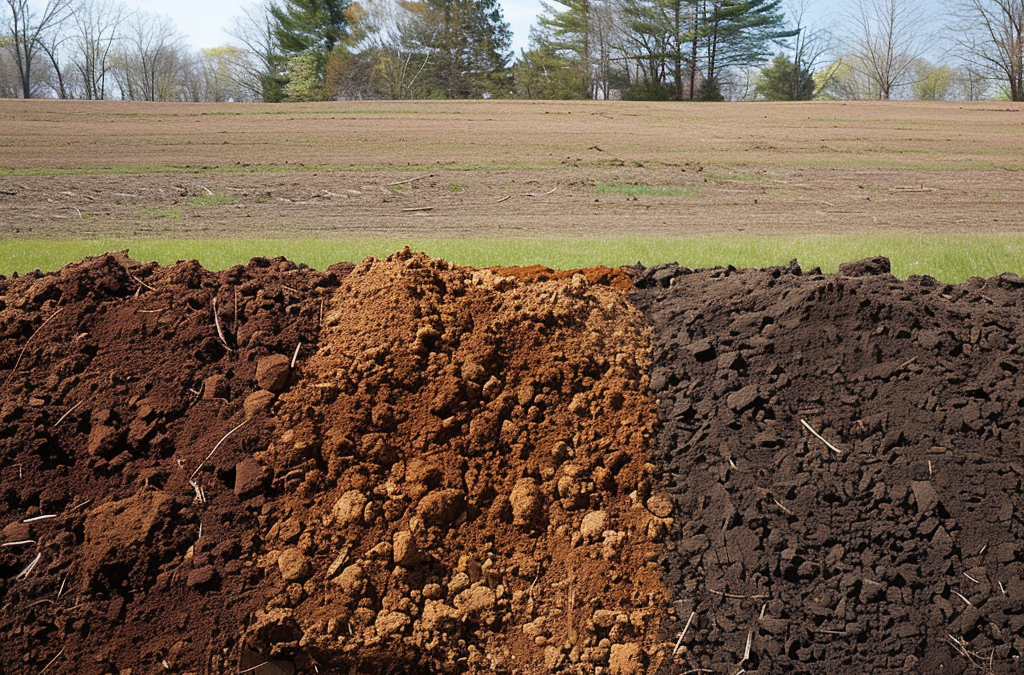Tate’s Property Care Guide: Unlocking the Secret to a Lush Connecticut Lawn, Its All in the Soil!
Hey there, green thumbs and lawn lovers! Ever wonder why some lawns look like they’ve been plucked straight out of a landscaping magazine, while others struggle to keep up? Well, here at Tate’s Property Care, we know the secret lies beneath the surface. Yep, we’re talking about the soil. Connecticut’s got a diverse palette of soil types, and understanding this underground world is key to unlocking the lush lawn of your dreams. Let’s dive into the dirt and discover how to best care for your lawn, based on the soil it calls home.
Soil Types in Connecticut: A Lawn Care Game-Changer
Our beautiful state’s diverse topography and climate gift us with a wide array of soil types. From sandy beaches to fertile valleys, knowing your soil type is not just good to know; it’s crucial for the health of your lawn. Let’s break down what you’re working with and how to make it work for you.
Sandy Loam: The Connecticut Standard
Most lawns around here sit on sandy loam. It’s a bit finicky about holding onto moisture due to its sandiness, but it’s a champ at draining excess water. To keep your lawn in top shape, regular watering and adding organic matter will boost nutrient retention and keep your grass happy.
Clay Soil: The Tough Customer
Got clay soil? You’re not alone. It’s common in Connecticut’s inland areas, to hold onto water like there’s no tomorrow. This can make it tough for grass roots to breathe. But don’t worry, we’ve got tricks up our sleeve. Adding gypsum, aerating, and incorporating organic matter can transform that heavy soil into a welcoming home for your lawn.
Loam Soil: The Lawn’s Dream
Loam soil is where it’s at – not too sandy, not too clayey. It’s just right, holding onto moisture and nutrients in a way that makes grass sing. If you’re lucky enough to have loam soil, keep up with regular lawn care practices like fertilization and aeration to maintain its health.
Silty Soil: The Hidden Gem
Near rivers and floodplains, you might find silty soil. It’s super fertile and holds moisture well, but it can get compacted. To get the most out of silty soil, add organic matter and ensure proper drainage. This will help avoid compaction and keep your lawn looking lush.
Tailoring Your Lawn Care Strategy
Understanding and adapting to your specific soil type is the key to a vibrant, healthy lawn. A soil test can be a great starting point, giving you the inside scoop on pH levels, nutrient deficiencies, and more. Whether you’re working with quick-draining sandy loam or dense, moisture-loving clay, there’s a strategy to make your lawn the envy of the neighborhood.
FAQs from Tate’s Property Care
How do I figure out my soil type? A soil test is the best way to nail down your soil type. It’ll also clue you in on pH and what nutrients might be missing.
Can I change my soil type? While you can’t completely change your soil type, you can improve its structure and nutrient content. Amendments like organic matter for all soil types, gypsum for clay, and sand to improve drainage can make a big difference.
How often should I aerate my lawn? It depends on the soil. Sandy soils need less, while clay soils might need aeration annually or even semi-annually.
Do all soils need fertilization? Yep, but the type and frequency depend on your soil’s fertility and your grass’s needs. A soil test can guide you here.
Can poor lawn care hurt my soil? Absolutely. Overwatering, under-fertilizing, or neglecting aeration can lead to soil issues, negatively impacting your lawn’s health.
Alright, let’s dive into the world of plants and soils, matching some green buddies to the unique soil types you’ve listed. Given the diverse soil landscapes, it’s crucial to pick plants that vibe well with their underground homes. Here’s a laid-back guide to who likes living where:
Hollis Loam, Stony Phase, Shale Loam, Silt Loam
- Black-eyed Susan (Rudbeckia hirta)
- Sun: Full sun to part shade.
- Water: Medium. They’re pretty drought-tolerant once established.
- Purple Coneflower (Echinacea purpurea)
- Sun: Full sun is best.
- Water: Medium. They can handle drought but appreciate a drink during dry spells.
- Lavender (Lavandula)
- Sun: Full sun, the more, the merrier.
- Water: Low. They’re drought-tolerant. Overwatering? Nah, they’re not into that.
- Sedum (Sedum spp.)
- Sun: Full sun to part shade.
- Water: Low. These succulents store water in their leaves, making them drought champs.
- Juniper (Juniperus spp.)
- Sun: Full sun.
- Water: Low to medium. They’re pretty adaptable but lean towards the drier side.
Dutchess Loam, Stony Phase, Silt Loam, Shale Loam
- Daylilies (Hemerocallis spp.)
- Sun: Full sun to part shade.
- Water: Medium. They’re not too fussy but appreciate consistent moisture.
- Phlox (Phlox paniculata)
- Sun: Full sun to part shade.
- Water: Medium. Keep them happy with regular watering, especially in dry periods.
- Bee Balm (Monarda didyma)
- Sun: Full sun to part shade.
- Water: Medium to high. They like their soil on the moist side.
- Coral Bells (Heuchera spp.)
- Sun: Part shade to full shade.
- Water: Medium. They like a bit of moisture but hate wet feet.
- Yarrow (Achillea millefolium)
- Sun: Full sun.
- Water: Low to medium. They’re pretty drought-tolerant once established.
Pittsfield Fine Sandy Loam, Stony Phase
- Lavender (Lavandula)
- Sun: Full sun.
- Water: Low. Let them dry out between watering.
- Thyme (Thymus vulgaris)
- Sun: Full sun.
- Water: Low. They prefer drier conditions.
- Sage (Salvia officinalis)
- Sun: Full sun.
- Water: Low to medium. They can handle a bit of drought.
- Russian Sage (Perovskia atriplicifolia)
- Sun: Full sun.
- Water: Low. They thrive in dry conditions.
- Butterfly Bush (Buddleja davidii)
- Sun: Full sun.
- Water: Medium. They like a good drink but don’t overdo it.
Dover Fine Sandy Loam, Stony Phase
- Rock Rose (Helianthemum nummularium)
- Sun: Full sun.
- Water: Low. Perfect for those forgetful waterers.
- Creeping Thyme (Thymus serpyllum)
- Sun: Full sun.
- Water: Low. They’re all about that drought life.
- Sedum (Sedum spp.)
- Sun: Full sun to part shade.
- Water: Low. Water them sparingly.
- Catmint (Nepeta faassenii)
- Sun: Full sun to part shade.
- Water: Low to medium. They’re pretty easy-going.
- Artemisia (Artemisia spp.)
- Sun: Full sun.
- Water: Low. They prefer their soil on the dry side.
Essex Fine Sandy Loam, Stony Phase, Loam
- Astilbe (Astilbe spp.)
- Sun: Part shade to full shade.
- Water: Medium to high. They love moist, well-drained soil.
- Ferns (Various spp.)
- Sun: Part shade to full shade.
- Water: Medium to high. Keep them moist for happy fronds.
- Hostas (Hosta spp.)
- Sun: Part shade to full shade.
- Water: Medium. They like consistent moisture but nothing soggy.
- Rhododendrons (Rhododendron spp.)
- Sun: Part shade, especially sheltered from harsh afternoon sun.
- Water: Medium. They prefer well-drained, moist conditions.
- Hydrangeas (Hydrangea spp.)
- Sun: Part shade to full sun (depending on the variety).
- Water: Medium to high. They drink up quite a bit, especially in full sun.
Remember, these are general guidelines. Local conditions like humidity, wind, and soil depth can affect these needs. Always keep an eye on your plants; they’ll tell you if they’re happy or if they need a bit more care in the sun or water department.
Embracing Connecticut’s diverse soil types is your first step toward a lawn that not only boosts your curb appeal but also becomes a source of pride. At Tate’s Property Care, we believe understanding the ground beneath your feet is the foundation of great lawn care. Remember, the secret to a standout lawn starts with the soil. Let’s make your lawn a testament to the care and knowledge you invest in it.

